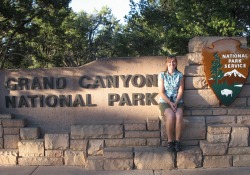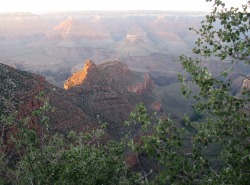|
Tucked out of sight of tourists is a beige building off Albright Avenue which houses over 200,000 museum artifacts. It is not routinely open or advertised to the public but is available for toursupon request in reasonably sized groups. Opening the door you are greeted by a tinny tune announcing your presence to museum staff. I was joined by a grandmotherly volunteer, archaeology intern, two from the fire crew, and a group from the SCA (Student Conservation Association). Standing in what serves as their lobby, a large display case houses a 50lb+ clay pot found in the Park by human types who thought they could sell it to an art dealer, they in turn, being honest folk, notified NPS who went and retrieved it. The curator who led the tour stated that the current trend in collection development was to leave artifacts in situ unless they are threatened by human disruption and theft. Accompanying the pot were a variety of items including a chuckwalla, preserved agave plant, and a species of skunk smaller than your average Pepe Le Peu, with spots arranged in several parallel stripes running the length of its body. On the wall facing the entrance were a sampling of dust jackets announcing Grand Canyon’s affair with high and lowbrow literature including Brighty, Ten Who Dared, and my favorite, a kitschy romance, The Nurse from Grand Canyon, featuring your usual light-skinned variety female and a swarthy man standing behind her with a protective hand on her arm.
Further in we found the natural history collection, which began with the shellacked skull of a giant ground sloth. We proceeded to a patch of dirty hair, and finally a generous mound of dung…which led to a story I had read about in The Incredible Grand Canyon: Cliffhangers and Curiosities. This entails a human explorer in Rampart Cave who threw aside his flaming torch when his examination of the area was complete. Being the ignorant type who would probably flick a burning cigarette out the window in high fire season, or leave his campfire burning, neither did he recognize that a burning torch in a cave was not impervious to disaster, especially when that particular cave was filled with thousands of pounds of 40,000 year old ground sloth poo. Apparently, even at a ripe old age, it holds its smell, which is perhaps why the explorer abruptly left the cave to begin with. Well, that desiccated dung smoldered for a year, and attempts by the Park Service to put it out was met with public outcry. To an equally ignorant public, it doesn’t make sense to spend thousands of dollars and manpower on putting out flaming turds, but what they didn’t have an appreciation for was that the cave was a treasure trove of artifacts offering clues to our much pondered past. Sadly, many of these clues were destroyed. There was an arsenic laced cabinet of taxidermy, and a variety of fossils which I can’t recall the names of—hollow shells and imprints of creatures that lived in an aquatic environment. One of those things to ponder as you walk within the canyon, dying of thirst, you collapse upon a layer of limestone to find the tunnels of sea worms and ancestral barnacles staring you in the face, the suggestion of water haunting your swollen tongue. It was revealed that the squirrel bodies were often used in still photography since the real fluff balls—like birds in constant motion—were not interested in posing for their picture. Later, at the Yavapai Observatory in gift shop #27 I thought the image of a tufted eared Kaibab Squirrel on a magnet looked suspiciously glassy eyed. On to bent twig figures thought to date back 9,000 some years. It is somewhat of a debate whether these animal shaped effigies made of willow were toys or mystical charms meant to bring a successful hunt. Folsom and Clovis among the projectile points, a stone axe, wooden ladles painstakingly repaired with agave fiber when threatened to split, bowls, a man’s fiber shoe, and a colander of sorts meant for keeping stored seeds from getting mildew—one of six known to exist. Toward the end of the cultural history lecture the lights went out and the back-up system (significantly dimmer) went on. I expected the ghosts of miners and Ancestral Puebloans to rise from the objects still heavy with their essence. A thunderstorm passed overhead. I ventured out, past the mural on the wall representing the nine foot wingspan of a condor, past the delicate nurse, and the petrified lizards. Into the rain I went. Nothing is delicate in the desert. These rain drops were the size of satellite dishes. Next stop was The Shrine of the Ages, a building under remodel with unique architecture (the only mundane architecture in the Park being tourist restroom facilities, and every last structure in Market Plaza adjacent to Mather Campground), housing offices and a chapel. A cemetery abuts this building where old and new settlers to the area are laid side by side. A blacksmith, a ranger, an artist, a mother. At the Yavapai Observatory I found a cluster of tourists both marveling and cursing at the mist filled chasm. Points of light shone on plateau and butte, a fork of lightning jolted my sensibilities. No one oohed or aahed so I felt that mine were the only human eyes that saw it. My camera batteries ran low as I tried to capture what no lens can—the feeling of presence. Ancient stories entombed in rock. I wondered if the gallon of milk I purchased on my way home would some day be documented in accounts written by future humanoids. I now sit in front of a glowing screen, paling in comparison to the round glowing rock orbiting the pines outside my trailer window.
1 Comment
Meg
6/27/2010 02:11:15 pm
The Nurse From Grand Canyon huh? sounds intriguing!
Reply
Your comment will be posted after it is approved.
Leave a Reply. |
AuthorJenny Gapp, has twenty years experience as a teacher librarian, four seasons as a seasonal state park ranger assistant, and two summers adventuring with National Parks in an official capacity. Archives
February 2024
Categories
All
|
 RSS Feed
RSS Feed



